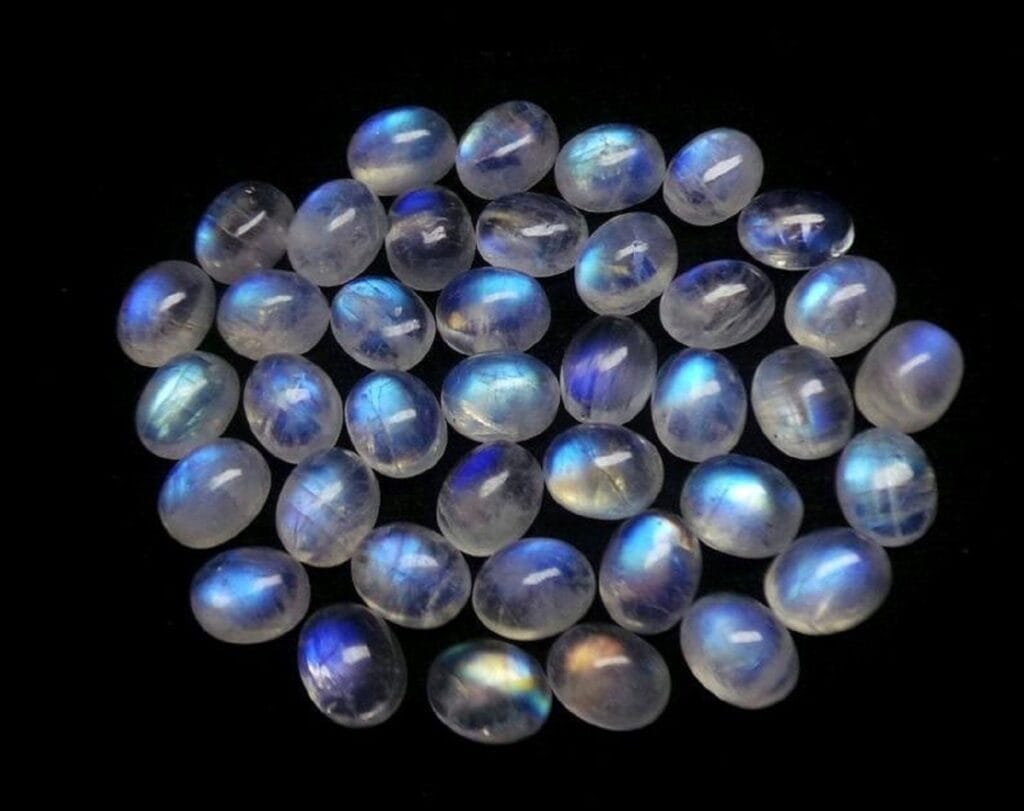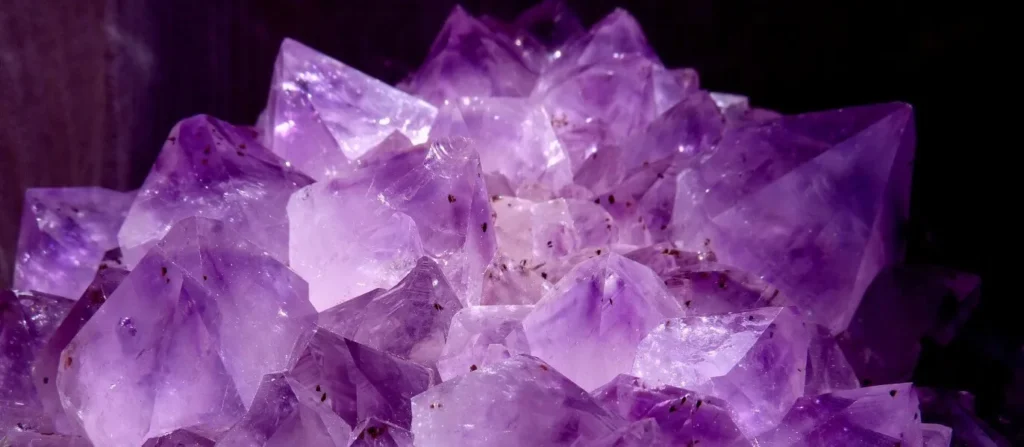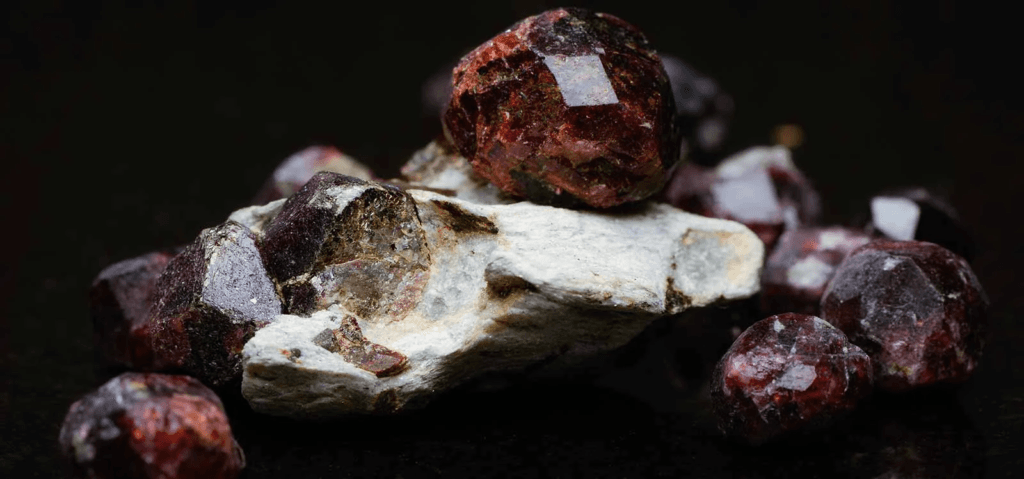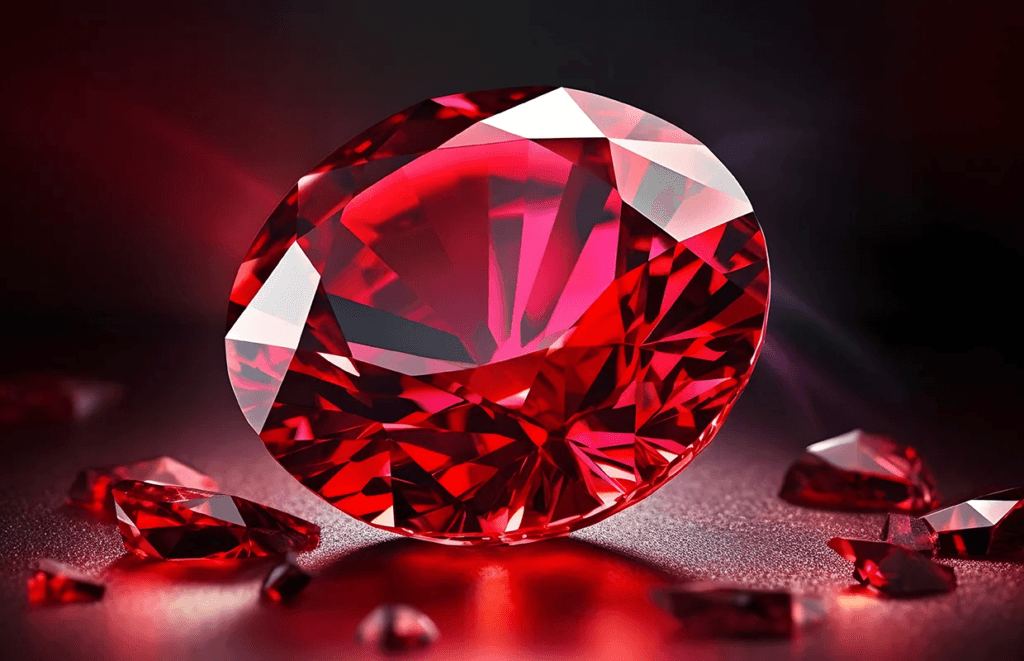Introduction
Moonstone, with its ethereal glow and enchanting aura, has captivated hearts and minds for centuries. This gemstone, known for its mesmerizing adularescence—a phenomenon where light scatters within the stone, creating a magical, moon-like glow—has been a favorite among gem enthusiasts and spiritual seekers alike. India’s contribution to the world of moonstone is significant, particularly from the regions of Bihar and Andhra Pradesh, where some of the finest moonstones are mined. These regions not only provide high-quality moonstones but also contribute to the rich cultural and historical tapestry associated with this gem. Moonstone’s allure extends beyond its physical beauty; it is revered for its associations with mysticism, intuition, and divine feminine energy, making it a staple in jewelry, healing practices, and astrology.
What is Moonstone?
Moonstone is a type of feldspar mineral, specifically an orthoclase and albite composite. Its unique layered structure causes the adularescence effect, where light moves across the stone, creating a shimmering light effect akin to moonlight on water. This phenomenon sets moonstone apart from other gemstones. Moonstones from Bihar and Andhra Pradesh are particularly prized for their vibrant hues and durability. The hardness of moonstone, rated between 6 and 6.5 on the Mohs scale, makes it suitable for various types of jewelry, from rings to pendants. Moonstone comes in several varieties, including blue, white, peach, rainbow, and green, each with unique optical properties. Compared to opal and labradorite, moonstone’s glow is more subtle and mystical, adding to its charm.
History and Cultural Significance of Moonstone
The history of moonstone is steeped in mythology and ancient beliefs. In Hindu mythology, moonstone is believed to be formed from solidified moonbeams and is associated with the moon god, Soma. The Greeks and Romans also revered moonstone, linking it to their moon goddesses, Diana and Luna, and believing it brought love and wisdom. In India, moonstone has a prominent place in Vedic astrology and Ayurvedic healing practices. It is believed to enhance intuition, emotional balance, and spiritual growth. The gemstone experienced a resurgence in popularity during the 1960s and 1990s, becoming a favorite in New Age healing practices and jewelry design.
Where is Moonstone Found?
India is renowned for its high-quality moonstone deposits, particularly in the regions of Bihar and Andhra Pradesh. The moonstones mined from these areas are known for their exceptional adularescence and rich earthy tones. The mining process in these regions is meticulous, ensuring that only the finest moonstones are brought to the market. Moonstones from Bihar and Andhra Pradesh are highly valued for their unique characteristics, setting them apart from those found in Sri Lanka, Tanzania, Myanmar, Brazil, and Australia. Indian moonstones are celebrated for their durability and more subdued, earthy colors, which many collectors find particularly appealing.
However, the process of mining moonstone comes with challenges. Ensuring sustainable mining practices and ethical sourcing is crucial. Fair-trade practices are essential to support local miners and preserve the environment. The Indian gem industry is increasingly focusing on these aspects to maintain the high standards of moonstone production.
Physical and Metaphysical Properties
Physically, moonstone is composed of orthoclase and albite feldspar, creating a layered structure that causes its signature glow. With a hardness of 6-6.5 on the Mohs scale, moonstone is durable enough for various types of jewelry. The gem comes in several varieties and colors, each with its own unique appeal. The light refraction through the layers of feldspar gives moonstone its enchanting adularescence.
Metaphysically, moonstone is believed to be connected to feminine energy and intuition. It is often associated with emotional healing and stability, making it a popular choice for those seeking to enhance their spiritual and emotional well-being. Moonstone is primarily linked to the Third Eye (Ajna) and Crown (Sahasrara) chakras, promoting clarity, insight, and meditative energy.
Top Benefits of Wearing Moonstone
Wearing moonstone offers numerous benefits, including:
- Emotional Balance: Moonstone is known for its ability to stabilize emotions and promote inner peace, making it an excellent choice for those dealing with stress or emotional turmoil.
- Intuition & Insight: The gemstone is believed to enhance decision-making and spiritual awareness, helping individuals connect with their inner selves.
- Hormonal Support: Moonstone is said to balance hormones, making it particularly beneficial for women’s health.
- Creativity & Inspiration: Ideal for artists, musicians, and writers, moonstone is thought to stimulate creativity and inspiration.
- Protection & Luck: Moonstone is believed to shield against negativity and attract fortune, offering a protective aura to its wearer.
- Healing & Stress Relief: The gem is known for its calming properties, reducing stress and promoting mental clarity.
- Feminine Energy: Moonstone enhances divine feminine power, fertility, and maternal instincts, making it a popular choice for women.
- Traveler’s Stone: Traditionally, moonstone is used by travelers for protection and guidance, providing a sense of safety during journeys.
Moonstone in Jewelry: Aesthetic & Fashion Appeal
Moonstone’s shimmering glow makes it a timeless choice in jewelry. It is commonly used in various types of jewelry, including rings, necklaces, bracelets, and earrings. The placement of moonstone jewelry can affect its metaphysical benefits. For example, wearing moonstone as a pendant near the heart is believed to enhance emotional balance, while wearing it on the forehead as a headpiece can enhance intuition and insight.
Moonstone is also considered an affordable luxury, serving as an alternative to more expensive gemstones like diamonds and opals. Proper care and maintenance are essential to preserve its beauty, including gentle cleaning and avoiding exposure to harsh chemicals.
Moonstone & Astrology: Zodiac & Birthstone Significance
Moonstone is especially beneficial for certain zodiac signs:
- Cancer, Scorpio, Pisces (Water Signs): The gemstone enhances intuition and emotional stability for these signs.
- Libra: Moonstone aids in decision-making and life transitions, making it a valuable gemstone for Libras.
- June Birthstone: Moonstone is one of the three official birthstones for June, offering unique benefits to those born in this month.
In Vedic astrology, moonstone is recommended for its calming and harmonizing effects. Astrologers often advise wearing moonstone to balance emotional energies and enhance spiritual growth, making it a powerful gemstone for various astrological remedies.
The Future of Moonstone: Demand & Market Trends
Moonstone’s popularity is on the rise, driven by its use in gemstone jewelry and spiritual healing. Ethical sourcing and sustainable mining practices are crucial for the responsible gemstone trade. The fashion industry is increasingly incorporating moonstone into luxury jewelry brands, recognizing its unique appeal and metaphysical benefits. Market trends indicate a potential price appreciation due to the growing demand for high-quality moonstone, making it a valuable investment for collectors and gem enthusiasts.
Conclusion
Moonstone’s rarity, beauty, and unique connection to Bihar and Andhra Pradesh make it a special gemstone. Its emotional, spiritual, and aesthetic benefits add to its allure, making moonstone a valuable addition to any jewelry collection. Exploring moonstone jewelry offers a unique opportunity to experience its mystical glow and profound benefits, enhancing one’s overall well-being. As the world continues to appreciate this enchanting gemstone, it is essential to prioritize ethical sourcing and sustainable practices to ensure the continued legacy of moonstone for future generations.

-
Who is Sonam Raghuwanshi? Understanding Their Influence on India’s Political Landscape in 2025

Sonam Raghuwanshi rose to national prominence when accused of orchestrating her husband’s murder during their honeymoon — a crime that unfolded across states and captured media attention. This case has spotlighted her name across keywords like sonam raghuwanshi, sonam raghuwanshi news, sonam raghuwanshi latest news, sonam raghuwanshi case, sonam raghuwanshi indore, sonam raghuwanshi boyfriend, sonam…
-
Keezhanelli Uses – Exploring Origins, Health Benefits, Intake limits and more

Keezhanelli leaves, derived from the plant Phyllanthus niruri, are celebrated in traditional medicine systems for their wide-ranging health benefits. Known by various names around the world, such as stonebreaker, seed-under-leaf, and bhumyamalaki, these leaves have a rich history and a variety of uses. In this article, we will delve deep into the world of Keezhanelli…



